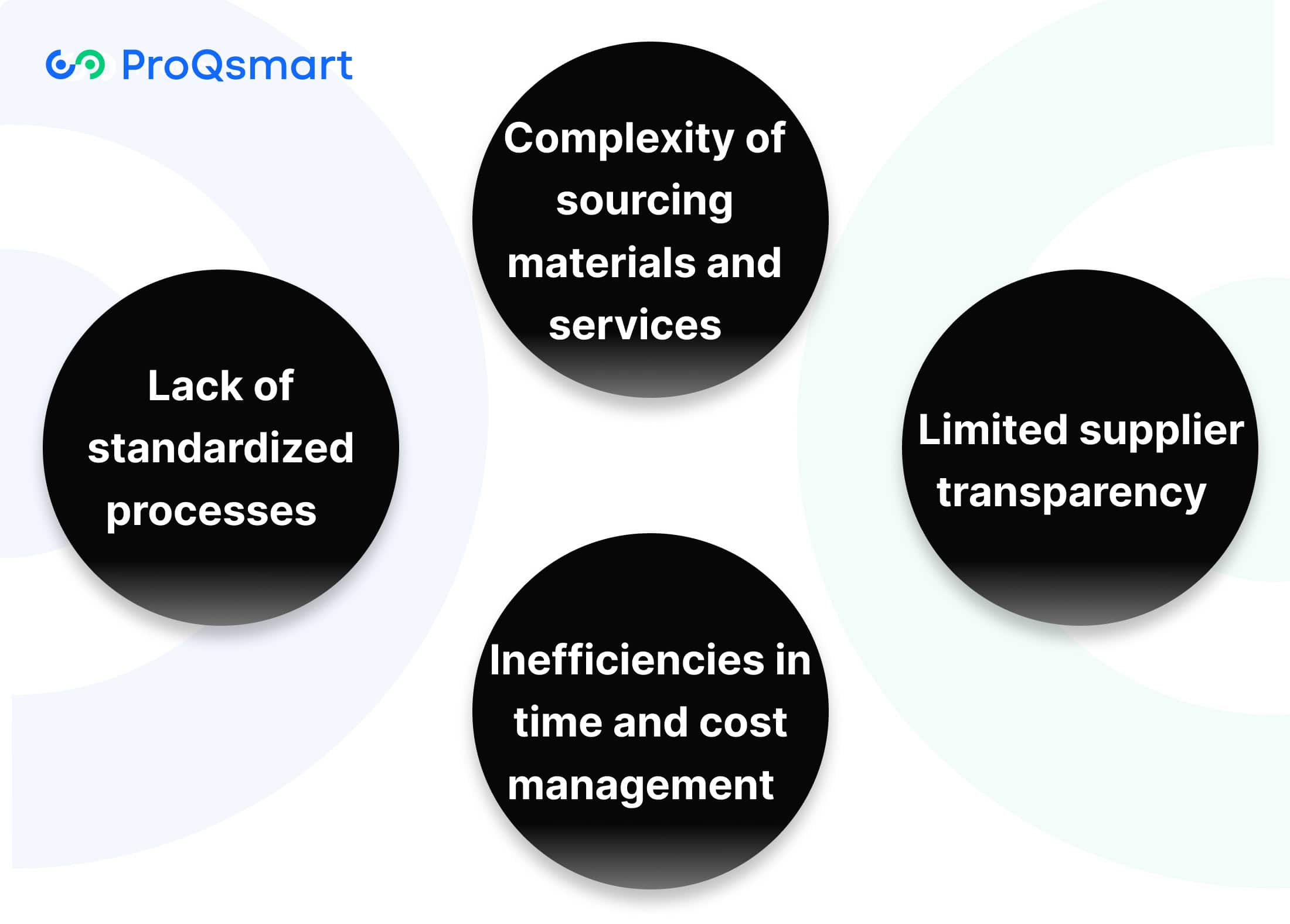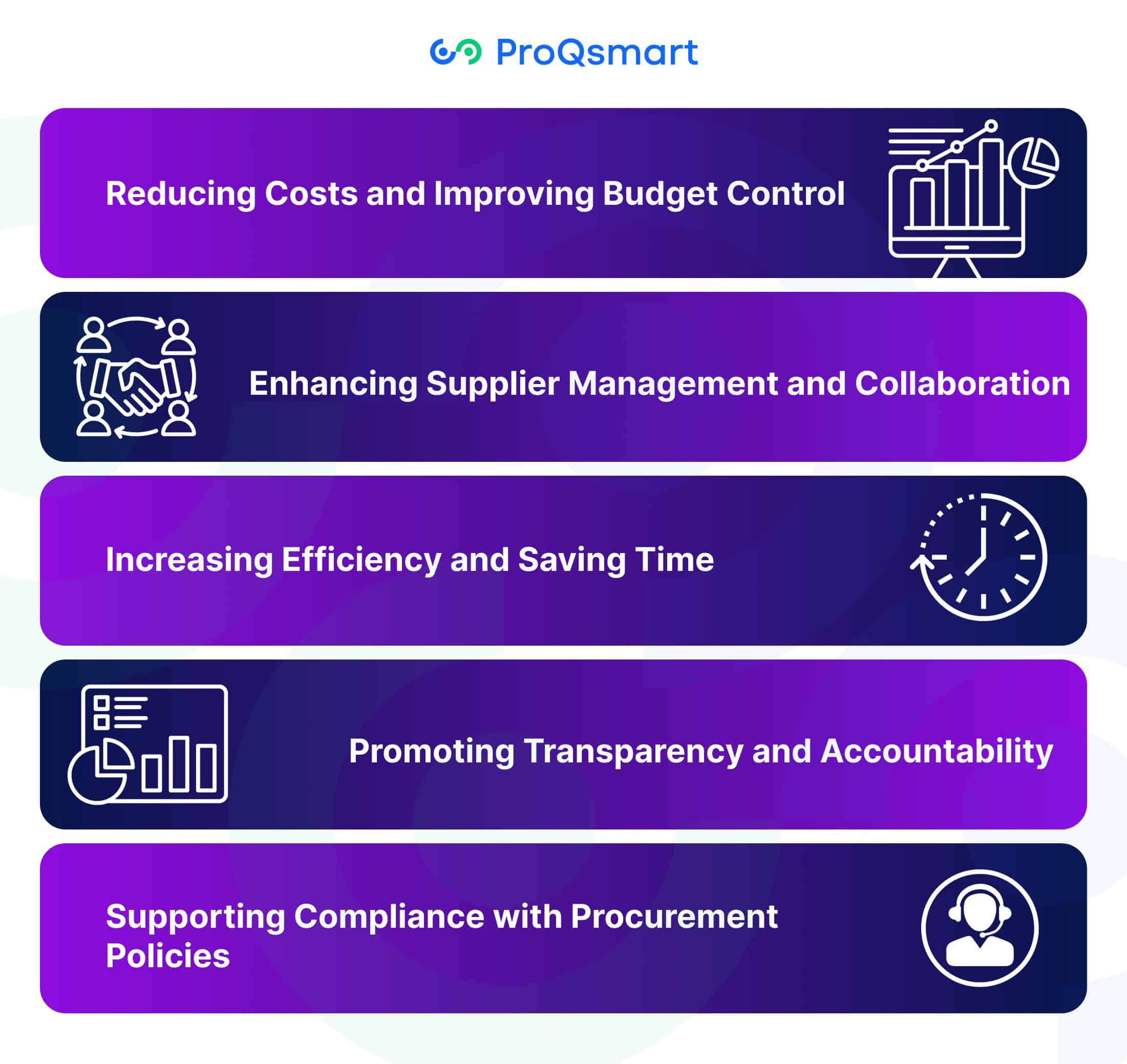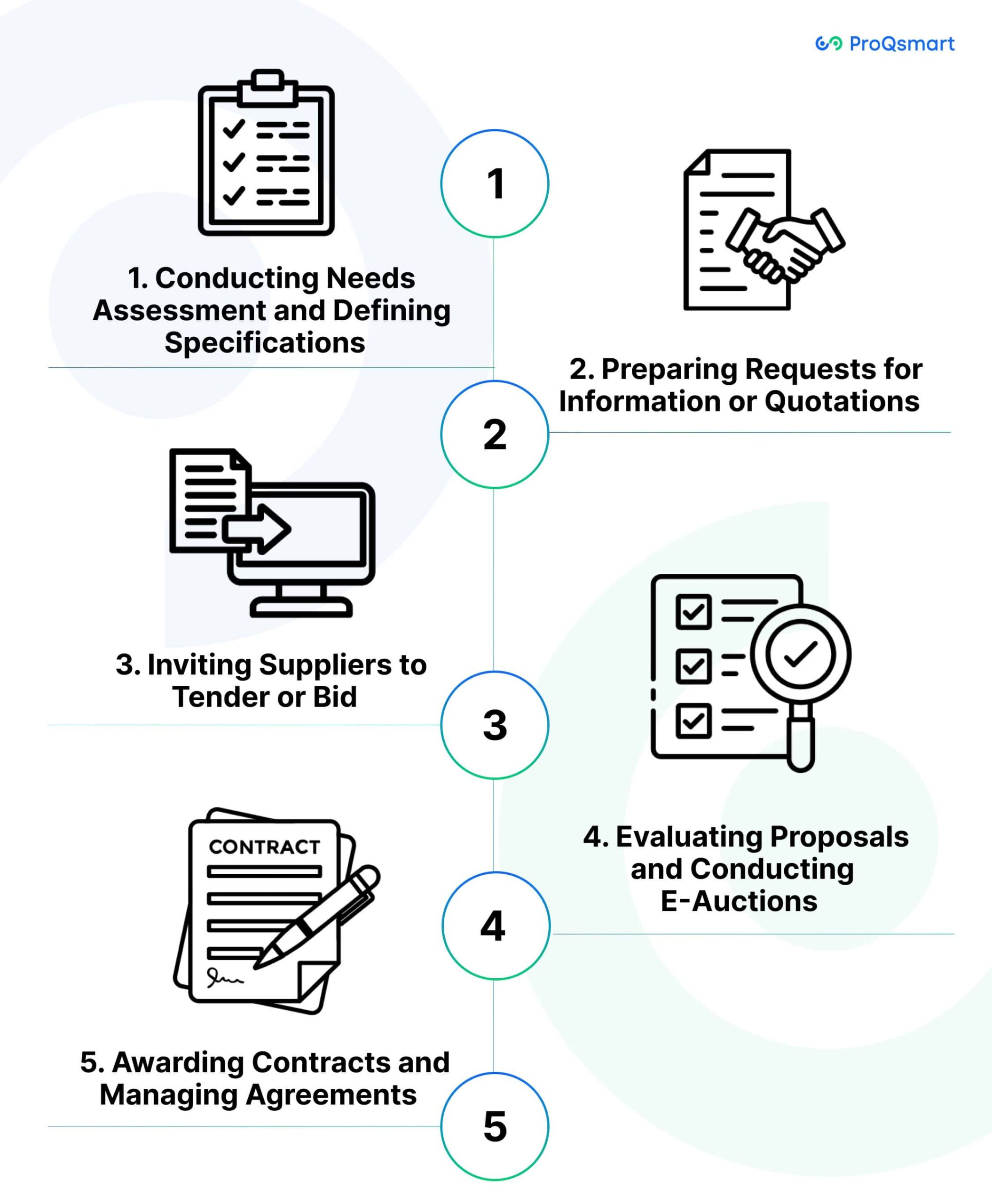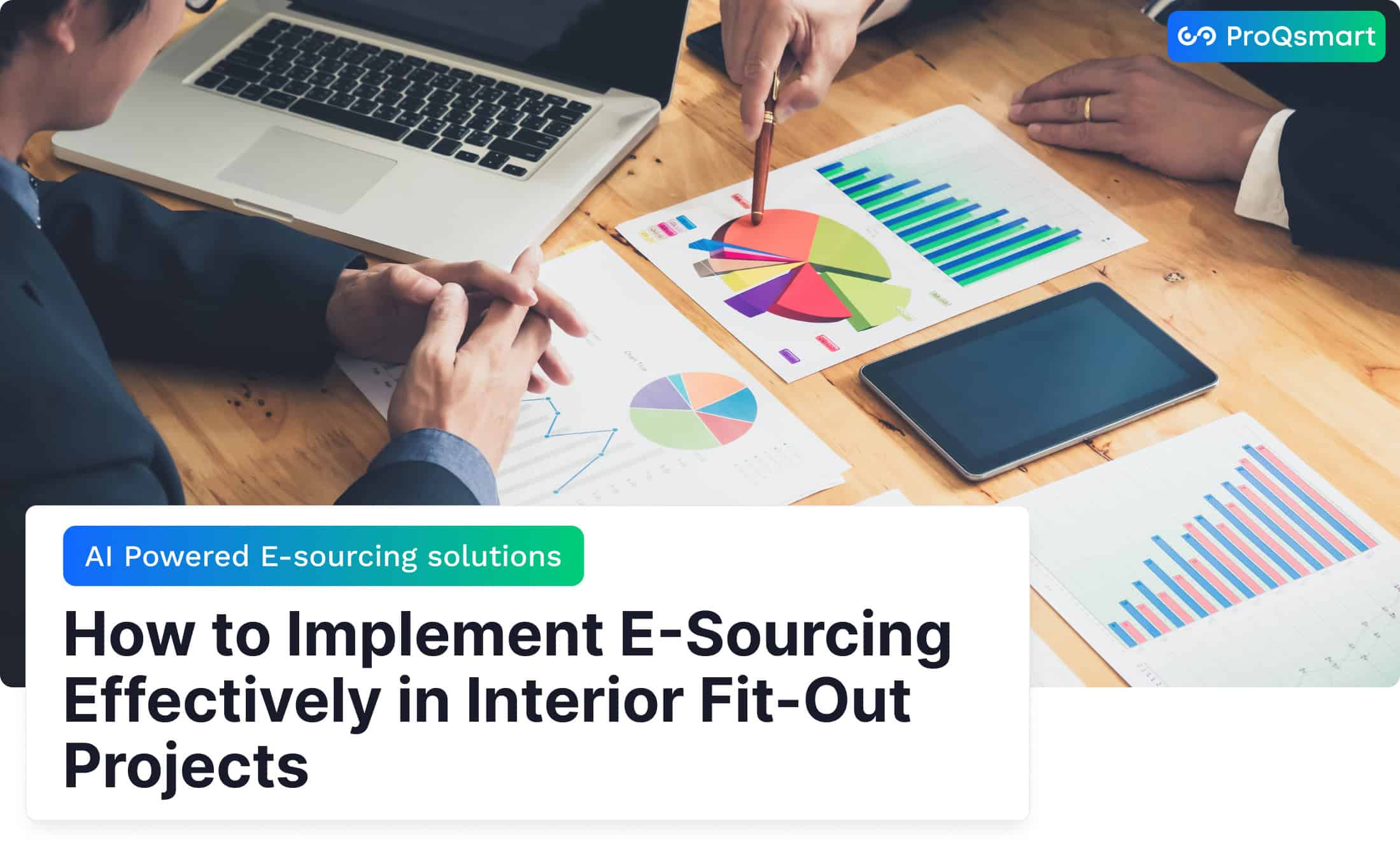E-sourcing refers to the practice of using electronic tools and online platforms to streamline and improve procurement activities. That encompasses the entire process from finding the right suppliers to negotiating the contract. It improves the sourcing process by giving teams clear, centralized access to supplier databases, streamlining communication, and automating bid management.
E-sourcing is an extremely effective way for businesses to streamline their processes, save money, and increase transparency in their interactions with suppliers. Through the adoption of e-sourcing, organizations can better take advantage of data analytics to improve their decision-making and make sure that procurement policies are being followed.
Most importantly, it enables scalable workflows, perfect for organizations small and large. Whether managing an increased number of vendors or striving for greener sourcing methods, e-sourcing provides effective solutions to exceed today’s procurement challenges. Its role in driving operational excellence is what makes it such a powerful tool to today’s procurement professionals.
What is E-Sourcing?

E-sourcing is a process-driven, methodical approach to identifying and evaluating suppliers. It leverages technology to centralize all supplier data into one place, making it easier for procurement teams to evaluate all options, quickly and efficiently.
By using template-based projects like RFx—like RFQs, RFPs, and RFIs—procurement professionals can start a sourcing task with less upfront work. Advanced analytical algorithms continue to make this process more efficient by determining the best supplier fit based on criteria established internally.
For example, e-Auctions give suppliers the ability to bid against each other in real time, encouraging competitive pricing and quicker negotiations.
Importance of E-Sourcing in Procurement
E-sourcing brings procurement into the future by eliminating bottlenecks with easy to manage workflows and collaboration. It encourages data-driven decisions with dynamic reporting tools that save you hours of manual work.
By providing an auditable trail, it helps to ensure that you are operating in compliance with regulatory standards. Procurement professionals see increased supplier participation due to e-sourcing.
This method saves taxpayer dollars by fostering competitive pricing and driving innovation and efficiency in sectors such as manufacturing and construction
Challenges in Traditional Sourcing for Interior Fit-Out

The traditional sourcing challenges for interior fit-out projects can be immense, affecting project efficiency, cost, and delivery speed. Add in outdated processes, communication gaps, and a lack of standardization and the challenges grow exponentially. These challenges can sink even the most carefully orchestrated projects. Here, we take a closer look at these typical challenges and roadblocks.
“Well-structured RFPs have a lot to recommend them. They lead to better project outcomes, better alignment with project goals, and a greater likelihood that the most qualified contractor is selected”.
Download Editable RFP Template for your industry!
Complexity of sourcing materials and services
Interior fit-out contracts often require complex management of a broad spectrum of suppliers and materials, all with differing specifications and needs. Managing dozens of vendors and subs can be a daunting task. This is even more critical on quality-sensitive items like flooring, lighting, and custom furniture where quality expectations can greatly differ.
It’s no small task even selecting high-quality marble for flooring. You need to check supplier credentials, visit factories, inspect samples and ensure the quality is uniform across batches – all of which require time and a sharp eye. Coordinating supplier delivery schedules with the overall project timeline can be a huge hurdle. When one area falls behind, it usually just sets back the progress of the whole project.
Limited supplier transparency
Traditional sourcing processes make it near impossible to access per supplier information including performance history, reliability, and more. For example, if there are not clear insights on a supplier’s past delivery performance or financial health, it turns into a game of chance to make the right decision.
This lack of visibility raises the risk of supplier under performance. It’s damaging to relationships when unexpected things arise. This lack of transparency introduces a multitude of risks that enhanced transparency through data-sharing tools could help address by creating trust and accountability.
Inefficiencies in time and cost management
Traditional procurement processes—including paper-based approval processes and extended negotiations—often add months to projects. Research indicates that sourcing can consume as much as 47% of a project’s total timeline. This doesn’t leave much wiggle room for the unexpected.
Unexpected costs like expedited shipping or material waste frequently occur because of a lack of planning. These inefficiencies can add up to real dollars and time lost on a project, making a compelling case for more efficient processes.
Lack of standardized processes
For one thing, traditional sourcing methods are not standardized in their practices or stringently enforced, so results vary widely. Without clear uniform templates or guidelines, procurement teams are forced to take a go-at-it approach, therefore making themselves more prone to mistakes.
Vague or inconsistent terms in the contract can result in major disputes with suppliers. This misunderstanding can push a project completion time even more. Having a set of standardized procedures will reduce the potential for confusion, instill greater accuracy, and keep all stakeholders on the same page.
Benefits of E-Sourcing in Interior Fit-Out

E-sourcing provids multiple benefits for interior fit-out projects. When organizations integrate technology into their sourcing processes, they empower themselves to better control their costs. In addition, it fosters better supplier collaboration and increases operational efficiency. Here, we discuss these benefits in depth.
Reducing Costs and Improving Budget Control
E-sourcing gives procurement teams the tools and insights to run more powerful negotiation strategies to guarantee suppliers submit their best price. By standardizing and taking the time to analyze supplier bids, organizations can quickly see who the most cost-effective suppliers are.
Moreover, e-sourcing platforms like ProQsmart, give teams the ability to track their spending in real time. This proactive tracking enables you to avoid cost overruns and ensure fiscal accountability for the duration of the project lifecycle.
Enhancing Supplier Management and Collaboration
Benefiting from strong supplier relationships are key to the success of interior fit-outs. E-sourcing platforms improve communication, allowing suppliers to better meet the needs of the project. Collaborative sourcing allows us to expedite the procurement process.
It further engages suppliers up-front, which minimizes rework and builds consensus around timelines and expectations. For instance, involving suppliers in the early design stage tends to lead to more cost-effective and creative solutions designed specifically for the project’s requirements.
Increasing Efficiency and Saving Time
While traditional procurement methods can be time-consuming, e-sourcing speeds up the cycle considerably. Automation removes manual processes, like RFI responses distribution, collection, and follow-ups, which can take hours and lead to mistakes.
These tools such as ProQsmart help to standardize processes and compare supplier proposals faster. This results in quicker decision-making, which is critical for adhering to aggressive project schedules.
Promoting Transparency and Accountability
Because e-sourcing tools create an audit trail with each action taken recorded and timestamped, they hold all users accountable. Increased visibility into supplier performance through real-time data insights builds accountability and trust among stakeholders. This enhanced transparency upholds the integrity of the procurement process while enabling more informed, data-driven decisions.
Supporting Compliance with Procurement Policies
E-sourcing builds automated checks into the process to help ensure compliance with organizational policies and regulatory requirements. By documenting procurement decisions at each step of the process, it makes compliance reporting easier and lessens the chance of non-compliance.
Tightly integrating workflows with ERP and other back-end financial systems helps maintain accuracy and consistency across operations.
The E-Sourcing Process Explained

E-sourcing simplifies the supplier selection and procurement process through online platforms driving improved precision and efficiency in securing the right services or products. On interior fit-out projects, where specifications are complex, collaborative design is often essential. E-sourcing helps identify the best buyer-supplier match.
In this series we’ll take a close look at each step in the e-sourcing process.
1. Conducting Needs Assessment and Defining Specifications
A thorough needs assessment is the foundation of effective e-sourcing. Key steps include identifying project goals and resource requirements. Consulting stakeholders to ensure alignment across teams is also crucial.
Additionally, analyzing historical data and market conditions helps refine needs. Clear project specifications ensure suppliers understand expectations, leading to better alignment. For example, specifying materials like fire-resistant drywall or modular furniture simplifies supplier selection.
Accurate assessments not only improve supplier matches but reduce procurement costs by eliminating unnecessary revisions.
2. Preparing Requests for Information or Quotations
Drafting RFIs or RFQs requires precision. It is important to include scope, timelines, technical requirements, and budget constraints. Specifying evaluation criteria and compliance expectations is also essential.
Providing a clear format for responses facilitates comparison. For example, an RFI, sometimes known as a Pre-Purchase Questionnaire, is used to prequalify suppliers. An RFQ is used to solicit pricing.
Providing clear and concise documentation reduces confusion and encourages more participation from suppliers.
3. Inviting Suppliers to Tender or Bid
Best practices for inviting suppliers include sharing comprehensive ITT (Invitation to Tender) documents outlining requirements. Ensuring confidentiality through secure platforms is also important. Setting clear submission deadlines helps manage the process effectively.
When all the ITT docs are uploaded, including policy docs around evaluation methods, this builds a sense of trust. It ensures informed submissions. For example, requiring certain LEED certification levels for sustainable projects filters bids to qualified vendors.
4. Evaluating Proposals and Conducting E-Auctions
Supplier proposals are evaluated using several criteria. These include alignment with project specifications, price competitiveness, and value-added services. Compliance with industry standards and certifications is also assessed.
E-auctions, held after the RFQ, increase transparency and open competition. They allow all qualified suppliers to compete on price to win the work. Reverse auctions, in which suppliers bid against one another to provide the lowest price, are especially well-suited to cost-sensitive categories.
5. Awarding Contracts and Managing Agreements
Essential steps in contract awarding include reviewing final proposals and negotiating terms. Drafting contracts with clear deliverables, timelines, and penalties is crucial. Digitally storing agreements ensures easy access and audits.
Post-award management keeps a project in compliance and allows managers to respond to unforeseen challenges. For example, periodic performance evaluations ensure suppliers are delivering on contractually specified terms. This builds trust and cooperation in the process.
Strategies for Effective E-Sourcing in Interior Fit-Out
E-sourcing tools have empowered businesses to save money, improve their operational efficiency, and scale their sourcing excellence. Interior fit-out projects require tight delivery on time, cost, and quality. The most effective e-sourcing strategies ensure each step directly focuses on hitting these important project objectives.
Planning procurement with clear objectives
Determining clear, measurable, achievable procurement goals is key. Objectives such as minimizing cost, maximizing on-time delivery, and ensuring quality inform the e-sourcing process to help make smarter sourcing decisions.
For instance, setting an overall target cost range for fit-out materials would necessitate disciplined sourcing to stay within budget. Clear alignment with all stakeholders, particularly designers and contractors, is key to preventing miscommunication.
Having a shared vision helps make sure that procurement is contributing to the project’s overall success.
Selecting reliable and qualified suppliers
The suppliers are the executioners. Key criteria for evaluation include:
-
Proven track record in delivering similar projects
-
Financial stability to handle large orders
-
Compliance with regulatory standards
-
Strong references from past clients
Site visits or audits, as part of thorough due diligence, can help confirm capabilities. For example, supplier evaluation through ProQsmart’s performance monitoring module, where suppliers are evaluated based on quality and timely delivery is maintained.
Leveraging technology for streamlined processes
Because e-sourcing tools automate the most repetitive tasks, they free consultants and contractors to save time and money. ProQsmart reduces the bidding process with e-tenders and allows teams to collaborate in real time, keeping you better coordinated and organized.
By integrating tools with existing systems, organizations can centralize workflows and decrease manual entry errors.
Standardizing templates for RFQs and contracts
Advantages include:
-
Faster creation of documents
-
Clearer communication of project needs
-
Simplified compliance with policies
Creating and maintaining templates that incorporate recent best practices helps ensure documentation stays up-to-date.
Monitoring supplier performance and ensuring quality
Setting clear metrics, including on-time delivery percentage and defect percentage, guarantees a high-quality outcome. Consistent reviews and feedback allow suppliers to understand expectations and deliver to them.
ProQsmart’s supplier performance monitoring feature simplifies this process, helping to build more robust, long-lasting relationships.
Features of E-Sourcing Tools for Interior Fit-Out
E-sourcing tools have quickly become an absolute necessity for procurement on interior fit-out projects. By providing superior features and functionalities, these tools facilitate more efficient operations, enhanced supplier engagement, and procurement that is both faster and more economical.
Below, we examine their key features and their value in tackling unique project challenges.
Visual RFQs and Product Libraries for Design Projects
Interior fit-out projects require very clear communication with suppliers. Visual RFQs (Request for Quotations) improve understanding by enabling buyers to add photos, drawings, or 3D models to their specs. For instance, architects might be able to attach specific design layouts to make sure that suppliers have a complete conception of the materials needed.
A product library simplifies the sourcing process. It gives you a single source home for approved materials and finishes, which makes it much easier to find the perfect fit. Visual features, like high-resolution product imagery, further ensure that supplier offerings meet aesthetic and functional project requirements.
Collaboration Tools to Enhance Communication
Especially in fast-paced, fast-moving interior fit-out projects, efficient collaboration is essential for success. E-sourcing tools often include shared document management, real-time messaging, task assignments with deadlines, and progress tracking dashboards.
These features enhance supplier engagement by centralizing all communication, keeping all parties informed and in the loop. Real-time updates, including alerts for bid updates or key project milestones, keep progress rolling and avoid lag time in communication.
AI-Driven Analytics for Decision-Making
AI-powered analytics quickly deliver actionable insights by analyzing supplier performance, pricing trends, and market data in real-time. ProQsmart uses powerful analytics to identify where you can find unnecessary costs.
It streamlines sourcing strategies and tracks suppliers to make sure they’re following contract terms. Analytics and data-driven decisions not only help mitigate risks, but help maximize procurement efficiency.
Workflow Automation for Seamless Operations
By automating procurement workflows, you can eliminate these repetitive tasks, like manual data entry or bid evaluation. This approach minimizes mistakes, expedites approval processes, and helps maintain a tighter project timeline.
With streamlined processes, it becomes almost effortless to execute common tasks such as subcontractor pre-qualification and bill of quantities management. ProQsmart’s automated tools show this hands-free approach in action.
Real-Time Bidding Platforms for Competitive Pricing
True real-time bidding platforms promote competitive pricing through open and transparent e-Auctions. Suppliers are able to compete against one another in real-time, guaranteeing the most competitive pricing and improved financial transparency.
E-sourcing tools, like ProQsmart’s e-tendering feature, make the bidding process easier while meeting compliance and transparency requirements, keeping costs in line with budgetary objectives.
Best Practices for Success in E-Sourcing
E-sourcing has quickly become a key part of today’s procurement process, with more than 75% of businesses using it to increase efficiency. Through the adoption of new technology and approaches, organizations can make vendor management more efficient, increase transparency, and save money. Gaining success with e-sourcing comes from making a thoughtful plan based on best practices.
Building a Robust Supplier Database
A robust, well-structured supplier database is the base layer of successful e-sourcing. Key components include accurate supplier profiles with contact details, certifications, and capabilities. Historical performance data and compliance records are also essential.
Risk assessments and financial stability evaluations further enhance the database’s effectiveness. Having all of their supplier-related information up-to-date will help you make informed decisions and build trusted supplier relationships.
For instance, adopting e-sourcing platforms such as ProQsmart centralizes supplier data, making vendor qualification and performance monitoring more streamlined. Having a healthy, diverse database of suppliers only helps you make the right decisions, mitigate risk, and amplify your long-term procurement objectives.
Using Standardized Templates for Consistency
Standardized templates, such as RFX documents, help organizations procure consistently and compliantly. These templates make the documentation process more efficient and minimize unnecessary errors, saving time in the process.
Tools like ProQsmart offer customizable templates that can be tailored for specific projects. This ensures alignment with organizational objectives while allowing flexibility.
Establishing Clear Communication Protocols
Best practices include defining clear channels for supplier interactions. Setting response timelines and expectations is also crucial. Additionally, sharing detailed project requirements and feedback fosters better collaboration.
Automation, as seen in collaborative platforms like ProQsmart, creates an environment for real-time collaboration. This eliminates downtime and creates a more efficient workflow. Open communication reduces the chance of miscommunication and creates an environment of transparency.
Implementing Effective Quality Control Measures
Regular audits and supplier assessments are vital for maintaining quality standards. Guided Buying and Reverse Auctions in e-sourcing platforms ensure compliance and competitive pricing.
Quality control measures, supported by data-driven insights, directly influence project success. These practices help in identifying potential issues before they escalate, ensuring that procurement objectives are met.
Tracking Performance Metrics for Continuous Improvement
Metrics to consider would be cycle time, supplier reliability, cost savings, and compliance rates. Applications such as ProQsmart, an e-sourcing tool, allow for real-time tracking and monitoring.
This streamlines processes and better connects procurement to strategic priorities. Continuous improvement through performance metrics ensures that organizations can adapt and enhance their e-sourcing strategies effectively.
Conclusion
For interior fit-out projects, e-sourcing is a game-changer. It speeds up the process of sourcing materials, reduces expenses, and increases quality and compliance management across suppliers. With the proper tools and strategies in place, teams can stop wasting time on bottlenecks and smooth out their processes. Further, it allows industry partners to remain competitive, doing the fine-tuned work needed to meet project objectives.
The move to e-sourcing isn’t simply a technological one—it’s a move toward making better decisions and achieving better results. In the end, using these tools results in stronger supplier relationships and much more efficient processes. Teams should be able to easily track progress, measure outcomes, and maintain quality and fidelity over time.
Ready to revolutionize your procurement process? Book a ProQsmart demo todayto begin exploring e-sourcing options and stay one step ahead on all of your interior fit-out projects. Discover how ProQsmart streamlines e-tenders, strengthens supplier relationships, and fosters efficiency.





